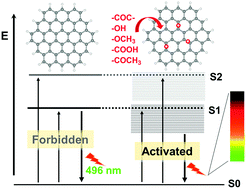Tuning the optical properties of graphene quantum dots by selective oxidation: a theoretical perspective†
Abstract
Graphene quantum dots (GQDs) are promising materials in a variety of optical applications, such as bioimaging and photovoltaics, but such applications are hindered by the poor understanding of their optical properties, in particular under the influence of functional groups. By theoretically studying the effects of the surface functionalization of oxygen-containing groups (–COC–, –OH, –OCH3, –COOH, and –COCH3) on the optical properties of a GQD, we found that the absorption and emission properties of the systems vary significantly depending on the chemisorption sites of the functional group. Remarkably, given that the optical gap of the GQD is just 2.68 eV, the optical gap difference between two GQD oxide isomers can be as large as 2.39 eV. The notably small optical gaps (<0.66 eV) in specific GQD oxide configurations indicate that each kind of these chemical groups may greatly facilitate non-radiative decay in photo-excited GQDs, consequently causing diminished photoluminescence efficiency. All the optical features in the GQD oxides are rationalized by electronic structure modifications upon the chemisorption of the oxygen-containing group(s) on the GQD surface. The functional group-coverage influence and Stokes shifting are also revealed. This study sheds light on the experimental inconsistencies regarding the role of O-containing groups in affecting the optical properties of GQDs and related materials and provides a valuable reference for further experiments.



 Please wait while we load your content...
Please wait while we load your content...